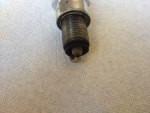A very good update!

I would like to first thank everybody that has offered suggestions. I could have not done it without you guys

I know that sometimes it gets tedious dealing with the same old problems but it's definitely great to talk them through.
After I kept getting no where with the FIP I decided to follow WWheeler's advice and focus on the WRD a bit. I found this thread which I think he was referring to:
http://www.sl113.org/forums/index.php?topic=9244.0Mind you I had always ASSUMED (yup, you know what's coming) that the WRD was working fine based on the air suction stopping as the car got warmer. After reading the WRD thread I decided to take it apart to see what was really going on if anything. I wanted to see how many "round shims" were there. When I first opened up the WRD I could see an original round shim at the top just underneath the retaining clip. Upon removing the retaining clip and removing all the shims I found 3 additional homemade shims

. There was a total of 4mm of shims in there which if I understand correctly is too much. I then put back 3 original shims totaling ~1.30 mm. (1mm, .1mm, .2mm)
I then started from a stone cold start. The air being sucked into the WRD seemed louder now. The other thing I noticed is that it took much longer for WRD to shut off air intake from before. Also, the WRD air intake did not completely shut off when just idling as it did before. The engine really had to be warm. I took the car for a quick spin and by the time I came back the WRD air intake was completely off.
While I was doing all of this I was monitoring the CO% with the Gunson. At the cold start, it fired immediately, and the CO% rose to 11% over 50 seconds. After 20 more seconds the CO% started dropping. Over the next 2 minutes the CO steadily declined to 1.5%. As it declined you could hear the WRD air intake slowing closing to the point of just shy of completely closed. This is where I decided to take the car out and get it 100% warmed up. Upon returning the WRD air intake was completely closed.

I now decided to move back to the FIP tuning. The adjustments I was using were shims under the BC and the FIP idle mixture screw. This was quite the iterative process but satisfying because things starting working as they are supposed to do. I started with a 2mm shim (original?)under the BC and ended up with adding an additional 1.5mm for a total of 3.5mm. I added a 0.15 shim each time in conjunction with dialing down the FIP idle mixture screw.
After doing all the adjustments (and driving in between) I settled on a CO of 4%

I think I that took me to almost MAX Lean on the FIP idle screw.
When I started all of the adjustments this morning the car would slightly miss every once in awhile and ONLY on hard acceleration. I diagnosed this (correctly I think?) being too lean in the mid and upper ranges. As I added shims under the BC(more rich) each time the missing slowly disappeared. The missing is 99.9% gone now. Now, I could add more shims under the BC to enrich the FIP over all ranges to possibly make it 100% but as I stated above I think I'm all out of FIP lean clicks. I would like to avoid going into the pump. I will drive for a bit and let everything settle. Overall, I am extremely happy with the results.

There have been many things that I have learned from this thread. But the two diagnostic tips are
1) Just because your WRD completely shuts down the air suction as it warms up doesn't mean that it is actually running or calibrated correctly.
2) As most of you stated, it's extremely important to drive the car after you make FIP & BC shim adjustments to let things "settle" and find their place. I saw a difference every time.
I did have a question regarding the cold start idle mixture starting at 11%. Is this typical and in spec? If anybody has a gunson meter and is willing to do a quick test(or if you just happen to know) I would like to know. I'm just trying to dot the "i"'s and cross the "t"'s so I can close the book on this thing

This is the plug color I ended up with. What do you think?
